In the past decade of developing custom software, we’ve witnessed numerous “next big things.” But Artificial Intelligence (AI) is different. It’s not just a new programming language or framework; it’s a fundamental shift in how we conceive, build, and maintain software. AI is moving from a standalone feature to the very foundation of modern software development.
This guide will cut through the hype. We’ll explore how AI custom software development is providing businesses with an undeniable strategic advantage, delve into the core applications that are delivering real value today, and provide a clear roadmap for leveraging this transformative technology.
The Advantage of AI in Custom Software Development
Many businesses still view AI as a cost center or a fancy add-on. The reality is far more impactful. Integrating AI into your software development process from the ground up is a strategic maneuver that creates a sustainable competitive edge. It’s the difference between building a car and building a self-driving car; both are vehicles, but their capabilities, value, and potential are worlds apart.
The strategic advantage lies in moving from reactive to proactive, from generic to personalized, and from manual to intelligent. AI-powered software solutions don’t just execute commands; they learn from data, anticipate needs, and optimize their own performance. This translates to:
- Unprecedented Efficiency: Automating complex, repetitive tasks within the software lifecycle, from coding to testing.
- Deeper User Engagement: Creating dynamic, adaptive experiences that feel personally tailored to each user.
- Enhanced Resilience: Building systems that can predict failures, defend against novel threats, and self-heal.
- Data-Driven Decision Making: Transforming raw data into actionable insights, empowering users and stakeholders alike.
By embracing an AI-first development approach, you’re not just writing code; you’re building an intelligent asset that grows smarter and more valuable over time.
Core Applications of AI in Building Custom Software Solutions
Let’s move from theory to practice. Here are the most impactful ways AI is being integrated into custom software development today.
1. Intelligent Code Generation & Autocompletion
Gone are the days of simple syntax highlighting. Modern AI-powered tools like GitHub Copilot and Amazon CodeWhisperer act as a pair programmer that has read almost every open-source project in existence.
- How it Works: These tools use large language models (LLMs) trained on vast codebases. They analyze your context and comments to suggest entire lines, functions, and even complex code blocks.
- Expert Insight: From our experience, this doesn’t replace developers; it augments them. It handles boilerplate code, suggests optimal algorithms, and introduces best practices developers might not have considered. This drastically accelerates development velocity and reduces cognitive load, allowing our team to focus on solving complex architectural problems rather than remembering API signatures.
2. AI-Powered Software Testing & QA Automation
Manual testing is a bottleneck. Traditional automated testing is rigid. AI-driven quality assurance is dynamic and intelligent.
- How it Works: AI algorithms can generate test cases based on user behavior patterns, automatically identify the most critical areas of the application to test after a code change (impact analysis), and even perform visual testing to detect UI glitches that scripted tests might miss.
- Expert Insight: We’ve implemented AI testing tools that learn from past bug reports and user sessions. This allows them to prioritize testing on features that are most prone to failure or most critical to the business, leading to a more robust and reliable software product and a significantly faster release cycle.
3. Proactive Error Detection & Intelligent Debugging
Finding the root cause of a software bug can feel like searching for a needle in a haystack. AI transforms this tedious process.
- How it Works: By analyzing log files, stack traces, and performance metrics in real-time, AI models can detect anomalies and correlate seemingly unrelated errors to pinpoint the root cause. They can then suggest specific fixes or direct developers to the exact line of problematic code.
- Expert Insight: We recall a complex issue involving a memory leak that only occurred under specific, rare conditions. An AI monitoring tool flagged a subtle pattern in garbage collection logs that a human would almost certainly have missed, leading us to the root cause in hours instead of days. This proactive error detection is a game-changer for software stability.
4. Predictive Analytics for System Maintenance
What if your software could tell you it’s going to fail before it actually does? This is the power of predictive maintenance.
- How it Works: AI models continuously analyze application performance metrics (CPU, memory, response times, database query performance) to establish a normal baseline. They can then forecast future load and identify signs of degradation, alerting teams to scale resources or patch issues before they impact users.
- Expert Insight: For a client with a seasonal e-commerce platform, we built a predictive model that analyzes traffic trends and automatically provisions additional cloud resources ahead of anticipated sales spikes. This prevents downtime during their most critical revenue-generating periods.
5. Hyper-Personalized User Experiences & Adaptive Interfaces
Static, one-size-fits-all user interfaces are becoming obsolete. AI enables software that adapts to individual users.
- How it Works: By leveraging machine learning on user data (behavior, preferences, past interactions), the software can dynamically customize its content, layout, and functionality. Think of a learning management system (LMS) that suggests courses based on your progress, or a CRM that surfaces the most relevant client information based on the upcoming meeting.
- Expert Insight: Personalization is not just about “recommended for you.” It’s about reducing friction. We developed an enterprise application that rearranges its dashboard and workflow for each user role, based on their most common tasks. This reduced the time to complete key actions by over 30%, directly boosting productivity.
6. Advanced Threat Intelligence & Anomaly Detection
Traditional security rules are reactive. They block known malicious IPs or signature-based attacks. AI-driven security is proactive and behavioral.
- How it Works: AI models learn the normal “behavior” of users and systems—typical login times, data access patterns, and network traffic. When a significant deviation from this baseline occurs (e.g., a user downloading gigabytes of data at 3 AM from a foreign country), the system flags it as a potential threat and can automatically trigger countermeasures.
- Expert Insight: This is crucial for defending against zero-day attacks and sophisticated insider threats. In one project, our anomaly detection system identified a compromised user account that was being used to exfiltrate data slowly, a pattern that would have been invisible to traditional rule-based security tools.
7. Conversational AI & Natural Language Interfaces
The future of human-computer interaction is conversation. Integrating conversational AI and Natural Language Processing (NLP) makes software more intuitive and accessible.
- How it Works: This goes beyond simple chatbots. It’s about building software that users can interact with using natural language. For example, a business intelligence tool where you can ask, “What were our top-selling products in the Midwest last quarter?” and get a structured report and chart in return.
- Expert Insight: The key here is context. We focus on building NLP models that understand the specific domain language of your business. A healthcare application needs to understand medical terminology, while a legal tech tool must comprehend legalese. This domain-specific training is what separates a useful assistant from a gimmick.
8. Automated Technical Documentation & Code Explanation
Documentation is often the most neglected part of software development services. AI is changing that.
- How it Works: AI tools can now analyze codebases and automatically generate documentation for APIs, functions, and classes. They can also create visual diagrams of the system architecture and keep everything updated as the code evolves.
- Expert Insight: This is invaluable for onboarding new developers and maintaining legacy systems. We use these tools to instantly create a “knowledge base” for a new project, saving dozens of hours of manual work and ensuring that documentation stays in sync with the code, a perennial challenge in software engineering.
9. AI-Optimized DevOps (AIOps) & Continuous Deployment
DevOps is about speed and reliability. AIOps supercharges this by injecting intelligence into the entire deployment pipeline.
- How it Works: AI can optimize build processes, predict which code changes are most likely to cause integration failures, and manage complex deployment strategies. It can also automatically roll back a release if it detects a spike in error rates, minimizing user impact.
- Expert Insight: In a complex microservices environment we manage, AIOps tools analyze the dependencies between services. When a deployment is initiated, the system intelligently determines the safest order to deploy services and can run targeted tests to verify the health of the entire ecosystem post-deployment, ensuring continuous delivery without sacrificing stability.
10. Legacy System Modernization & Code Optimization
Many businesses are trapped by old, inefficient, but critical legacy systems. AI provides a path forward.
- How it Works: AI can analyze monolithic, legacy codebases (e.g., in COBOL or VB.NET) and map their functionality. It can then assist in refactoring the code into modern, modular architectures (like microservices) and even suggest optimizations for performance and security.
- Expert Insight: We recently used AI-assisted tools to analyze a 15-year-old Java application. The tool identified dead code, suggested more efficient algorithms, and flagged security vulnerabilities related to outdated libraries. This provided a clear, prioritized roadmap for modernization, de-risking the entire project and saving months of manual analysis.
Business Outcomes: Leveraging AI for a Competitive Edge
The technical applications are impressive, but what do they mean for your bottom line? Investing in AI-driven software development translates to tangible business outcomes.
- Accelerated Time-to-Market: By automating coding, testing, and deployment, you can release new features and products faster than your competitors.
- Reduced Operational Costs: Intelligent automation leads to fewer bugs, less downtime, and more efficient use of developer time and cloud resources.
- Enhanced Customer Satisfaction & Retention: Hyper-personalized experiences and proactive problem-resolution create sticky, loyal users.
- Informed Strategic Decisions: The predictive analytics and data insights generated by your AI-powered software empower leadership to make smarter, data-driven decisions.
- Future-Proofing Your Business: Building with an AI foundation makes your software adaptable and scalable, ready to evolve with market demands and new technological opportunities.
Key Considerations for an AI-Focused Development Partner
Choosing the right team is critical. The wrong partner can lead to expensive, ineffective “AI-washing.” Here’s what to look for:
- Proven AI Expertise, Not Just Hype: Look for a portfolio with specific case studies. Do they have experience with the specific AI applications you need (e.g., NLP, computer vision, predictive analytics)?
- Data Strategy Capabilities: AI is nothing without data. Your partner must have a robust strategy for data collection, cleaning, labeling, and management. Ask them how they handle data governance and privacy.
- Focus on Business Problems, Not Just Technology: A strong partner will start by deeply understanding your business challenges and objectives, then recommend AI solutions that directly address them—not the other way around.
- Transparency and Explainability: Can they explain how their AI models work in terms you can understand? Avoid “black box” solutions where no one can explain the AI’s decisions, especially in regulated industries.
- Ethical AI Commitment: Do they have guidelines for building fair, unbiased, and ethical AI? This is crucial for maintaining your brand’s trust and integrity.
- Long-Term Partnership Mindset: AI models require continuous monitoring, retraining, and improvement. Ensure your partner is set up for a long-term relationship, not just a one-off project.
FAQ
1. Isn’t AI in software development just for tech giants like Google and Amazon?
No, that’s a common misconception. While tech giants pioneered these tools, the cloud has democratized AI. Through cloud platforms (AWS, Azure, GCP) and off-the-shelf AI services, businesses of all sizes can now leverage sophisticated AI capabilities without building their own models from scratch. The strategic advantage of AI is accessible to any forward-thinking organization.
2. Will AI replace my software developers?
In our expert opinion, no. AI is a powerful tool that augments and amplifies human developers. It automates the tedious, repetitive aspects of coding (like writing boilerplate code or fixing simple bugs), freeing up developers to focus on high-value tasks like architectural design, complex problem-solving, and understanding user needs. It elevates the role of the developer.
3. How much data do I need to start an AI project?
It depends on the application. For some use cases, like using pre-trained models for sentiment analysis, you may need very little data. For others, like building a custom recommendation engine, you will need a significant and well-labeled dataset. A good AI-focused development partner will conduct a data audit first and can often help you generate synthetic data or use data augmentation techniques if your initial dataset is small.
4. Are AI-powered software solutions more expensive?
There is an initial investment in expertise and computational resources. However, the long-term ROI is compelling. AI drives down costs through automation, reduces expensive downtime through predictive maintenance, and creates new revenue streams through personalized user experiences and data-driven products. It’s an investment in efficiency, resilience, and growth.
5. How do you ensure the AI in my software is unbiased and ethical?
This is a critical part of our process. We employ techniques like:
- Diverse and Representative Data: Ensuring training data doesn’t reflect historical biases.
- Bias Detection Tools: Actively testing models for discriminatory outcomes.
- Explainable AI (XAI): Using methods that make the AI’s decision-making process transparent.
- Human-in-the-Loop: Keeping human oversight for critical decisions.
We build ethical considerations into our development lifecycle from day one.
The Future of Software is Intelligent: How STS Software Helps Build Smarter Software?
At STS Software, with over a decade of experience, we’ve moved beyond just writing code. We are engineering partners in building intelligent, future-proof software solutions. We understand that successful AI custom software development is a blend of deep technical expertise, a clear business strategy, and a commitment to ethical principles.
Our process is collaborative and focused on your success. We don’t just implement AI; we help you identify the most valuable opportunities for its application, build a robust data foundation, and create a scalable, intelligent system that delivers a lasting competitive edge.
We invite you to move beyond the hype and explore the tangible value of AI. Let’s have a conversation about your business challenges and map out a strategic path to building the intelligent software your future depends on.
Contact STS Software today for a free, no-obligation consultation with our AI specialists.
Conclusion
The integration of AI into custom software development is no longer a speculative future; it is the definitive present. It represents a paradigm shift from building tools that process data to creating intelligent partners that generate insight and value. The strategic advantage gained through increased efficiency, profound user personalization, and proactive system intelligence is simply too significant to ignore.
The question for business leaders is no longer if they should incorporate AI, but how and with whom. By understanding the core applications and aligning with an expert, ethically-minded development partner, you can harness this transformative power to build not just software, but a smarter, more resilient, and more competitive future for your business.







